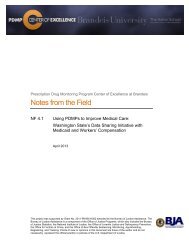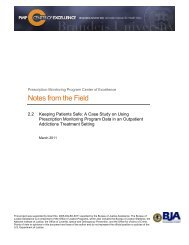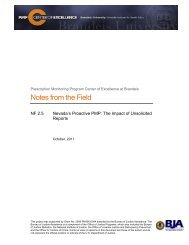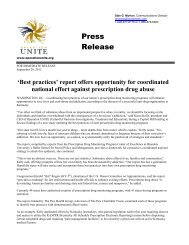slide presentation by Dr. Len Paulozzi - PDMP Center of Excellence
slide presentation by Dr. Len Paulozzi - PDMP Center of Excellence
slide presentation by Dr. Len Paulozzi - PDMP Center of Excellence
Create successful ePaper yourself
Turn your PDF publications into a flip-book with our unique Google optimized e-Paper software.
The Prescription <strong>Dr</strong>ug Overdose Epidemic<br />
and the Role <strong>of</strong> <strong>PDMP</strong>s in Stopping It<br />
<strong>Len</strong> <strong>Paulozzi</strong>, MD, MPH<br />
National <strong>Center</strong> for Injury Prevention and Control<br />
<strong>Center</strong>s for Disease Control and Prevention<br />
National <strong>Center</strong> for Injury Prevention and Control<br />
Division <strong>of</strong> Unintentional Injury Prevention<br />
1
The Public Health Model<br />
New or<br />
Persistent<br />
Problem<br />
Identified<br />
Remediable<br />
Risk Factors<br />
Identified<br />
Surveillance<br />
and<br />
Assessment<br />
Interventions<br />
Developed<br />
and Tested<br />
for Efficacy<br />
Proven<br />
Interventions<br />
Tested for<br />
Effectiveness<br />
2
Early surveillance data failed to detect a<br />
problem: DAWN 1990-1996, (Joranson, 2000)<br />
3
Perhaps because some data was left out:<br />
DAWN 1990-1998 data available when<br />
Joranson et al (2000) published<br />
4
Identifying the problem <strong>of</strong> prescription drug<br />
overdoses: First report, North Carolina, 2002<br />
5
Identifying the problem <strong>of</strong> prescription drug<br />
overdoses: Second Report, Maine, 2002<br />
6
Rate <strong>of</strong> unintentional drug overdose death in<br />
the United States, 1970-2007<br />
Death rate per 100,000<br />
10<br />
9<br />
8<br />
7<br />
6<br />
5<br />
4<br />
3<br />
2<br />
1<br />
0<br />
'70 '72 '74 '76 '78 '80 '82 '84 '86 '88 '90 '92 '94 '96 '98 '00 '02 '04 '06<br />
7
Number <strong>of</strong> <strong>of</strong> drug-induced deaths deaths compared compared with with other types<br />
<strong>of</strong> deaths, US, 1999-2006<br />
other types <strong>of</strong> deaths, US, 1999-2006<br />
8
Unintentional overdose deaths involving opioid<br />
analgesics now exceed the sum <strong>of</strong> deaths<br />
involving heroin or cocaine<br />
Number <strong>of</strong> deaths<br />
14,000<br />
12,000<br />
10,000<br />
8,000<br />
6,000<br />
4,000<br />
2,000<br />
0<br />
Opioid analgesic<br />
Cocaine<br />
Heroin<br />
'99 '00 '01 '02 '03 '04 '05 '06 07<br />
Source: National Vital Statistics system, multiple cause <strong>of</strong> death dataset<br />
9
Unintentional overdose deaths involving opioid<br />
analgesics parallel per capita sales <strong>of</strong> opioid<br />
analgesics in morphine equivalents <strong>by</strong> year,<br />
U.S., 1997-2007<br />
14000<br />
12000<br />
10000<br />
8000<br />
6000<br />
4000<br />
2000<br />
0<br />
Number <strong>of</strong><br />
Deaths<br />
'97 '98 '99 '00 '01 '02 '03 '04 '05 '06 '07<br />
*<br />
Opioid sales (mg/<br />
person)<br />
800<br />
700<br />
600<br />
500<br />
400<br />
300<br />
200<br />
100<br />
0<br />
Source: National Vital Statistics System, multiple cause <strong>of</strong> death dataset, and DEA ARCOS<br />
* 2007 opioid sales figure is preliminary.<br />
10
Opioid-analgesic-related death rates in 1999-2004<br />
and opioid analgesic prescription rates in 2002<br />
among men, Kentucky (<strong>PDMP</strong> data courtesy <strong>of</strong><br />
KASPER)<br />
11
Estimated numbers <strong>of</strong> ED visits for misuse or<br />
abuse <strong>of</strong> drugs <strong>by</strong> drug type, DAWN,<br />
United States, 2008<br />
Source: <strong>Dr</strong>ug Abuse Warning Network<br />
12
Age-specific rates <strong>of</strong> ED visits for nonmedical use <strong>of</strong><br />
opioid analgesics (OAs) and benzodiazepines (BZDs) ---<br />
DAWN, United States, 2004 and 2008<br />
MMWR June 18, 2010
Past month nonmedical use <strong>of</strong> prescription pain<br />
relievers <strong>by</strong> age group, NSDUH, 2002-2009<br />
18-25<br />
12-17<br />
12+
Past year initiates for specific illicit drugs<br />
among persons aged 12 or older –<br />
NSDUH 2008
Most recent source used <strong>by</strong> past year nonmedical<br />
users <strong>of</strong> pain relievers aged 12 or older,<br />
NSDUH, 2009<br />
NSDUH summary <strong>of</strong> national findings, 2009<br />
16
Health outcomes related to opioid analgesics,<br />
United States, 2007-2009<br />
>11,499<br />
~1,854,000<br />
Deaths: NVSS 2007; Treatment admissions are for primary use <strong>of</strong> opioids, TEDS data, 2008;<br />
ED visits are DAWN 2008; Abuse/dependence and nonmedical use past month are NSDUH 2009<br />
17
The Public Health Model<br />
New or<br />
Persistent<br />
Problem<br />
Identified<br />
Remediable<br />
Risk Factors<br />
Identified<br />
Surveillance<br />
and<br />
Assessment<br />
Interventions<br />
Developed<br />
and Tested<br />
for Efficacy<br />
Proven<br />
Interventions<br />
Tested for<br />
Effectiveness<br />
18
The Public Health Model<br />
New or<br />
Persistent<br />
Problem<br />
Identified<br />
Remediable<br />
Risk<br />
Factors<br />
Identified<br />
Surveillance<br />
and<br />
Assessment<br />
Interventions<br />
Developed<br />
and Tested<br />
for Efficacy<br />
Proven<br />
Interventions<br />
Tested for<br />
Effectiveness<br />
19
Top Three Opioids in Overdose Deaths<br />
State Year <strong>of</strong> Deaths 1st 2nd 3rd <br />
North Carolina 2001 Meth 80 Oxy 41 Hydro
Characteristics <strong>of</strong> unintentional pharmaceutical<br />
overdose deaths,<br />
West Virginia, 2006<br />
Characteristic No. (%)<br />
History <strong>of</strong> substance abuse 231 (78.3)<br />
Other mental illness 126 (42.7)<br />
Any rx drug involved with no prescription 186 (63.1)<br />
Nonmedical route <strong>of</strong> administration 66 (22.4)<br />
5+ prescribers <strong>of</strong> controlled substances/yr 63 (21.4)<br />
Previous overdose 50 (16.9)<br />
Total 295 (100.0)<br />
Sources: Hall et al, JAMA, 2008 and Toblin et al, J Clin Psych, 2010<br />
21
Characteristics <strong>of</strong> unintentional drug overdose<br />
deaths, Ohio, 2006-8<br />
Characteristic %<br />
Filled prescriptions from an average <strong>of</strong> five<br />
prescribers/year over 3 years among deaths <strong>of</strong><br />
patients in state <strong>PDMP</strong> (N=1,047)<br />
No prescription in the <strong>PDMP</strong> for an opioid among<br />
prescription opioid-related deaths (N=508)<br />
No prescription in the <strong>PDMP</strong> for methadone<br />
among methadone-related deaths (N=157)<br />
16<br />
25<br />
71<br />
Source: Ohio Department <strong>of</strong> Health at www.healthyohioprogram.org/diseaseprevention/dpoison/drugdata.aspx<br />
22
Risk factors for opioid poisoning/abuse among<br />
privately insured patients,<br />
Maine, last quarter <strong>of</strong> 2006<br />
Behavior during<br />
3 month period<br />
Odds Ratio<br />
(95% confidence<br />
interval)<br />
Use <strong>of</strong> 3+ pharmacies for opioids 1.96 (1.66-2.33)<br />
Rapid opioid dose escalation 1.59 (1.33-1.89)<br />
1+ early refill <strong>of</strong> an opioid<br />
prescription<br />
6.52 (5.39-7.89)<br />
12+ opioid prescriptions in 3 months 2.12 (1.73-2.61)<br />
Source: White et al, Am J Managed Care, 2009;15:897<br />
23
Combined opioid and sedative-hypnotic use<br />
increases risk <strong>of</strong> serious overdose events<br />
Group Health Consort Study, 1997-2005, Dunn et al, 2010<br />
24
High opioid daily dosage increases risk <strong>of</strong><br />
serious overdose events<br />
Group Health Consort Study, 1997-2005, Dunn et al, 2010<br />
25
Non-medical use per 10,000 retail<br />
prescriptions <strong>by</strong> drug, DAWN, 2004 – 2006<br />
* Includes all formulations<br />
Source: National estimates from DAWN, 2004-2006; Verispan VONA<br />
Presentation <strong>by</strong> <strong>Dr</strong>. Catherine Dormitzer to the Anesthetic and Life Support <strong>Dr</strong>ugs and <strong>Dr</strong>ug Safety and Risk<br />
Management Advisory Committees, May 5, 2008<br />
26
Non-medical use per 10,000 retail prescriptions,<br />
oxycodone <strong>by</strong> release type, DAWN, 2004-2006<br />
Sources: National estimates from DAWN, 2004-2006; Verispan VONA<br />
Anesthetic and Life Support <strong>Dr</strong>ugs and <strong>Dr</strong>ug Safety and Risk Management Advisory Committees, May 5,<br />
2008<br />
27
Possible remediable risk factors include:<br />
q Use without a prescription<br />
q Doctor/pharmacy shopping<br />
q Early refills and dose escalation<br />
q Combined use <strong>of</strong> prescription opioids and sedativehypnotics<br />
q Higher daily prescribed opioid dosages<br />
q Use <strong>of</strong> specific opioids or formulations, eg,<br />
methadone or extended-release formulations<br />
q Nonmedical route <strong>of</strong> administration, eg, injection<br />
28
The Public Health Model<br />
New or<br />
Persistent<br />
Problem<br />
Identified<br />
Remediable<br />
Risk Factors<br />
Identified<br />
Surveillance<br />
and<br />
Assessment<br />
Interventions Developed and Tested for<br />
Efficacy<br />
Proven<br />
Interventions<br />
Tested for<br />
Effectiveness<br />
29
State prescription drug monitoring programs<br />
VT<br />
WA*<br />
OR<br />
NV<br />
CA<br />
MT<br />
ID<br />
WY<br />
UT<br />
CO<br />
AZ NM<br />
ND<br />
MN<br />
SD<br />
WI<br />
NE<br />
IA<br />
IL<br />
KS<br />
MO<br />
OK<br />
AR<br />
MS<br />
NY<br />
MI<br />
PA<br />
OH<br />
IN<br />
WV<br />
VA<br />
KY<br />
NC<br />
TN<br />
SC<br />
GA<br />
AL<br />
ME<br />
NH<br />
MA<br />
RI<br />
CT<br />
NJ<br />
DE<br />
MD<br />
DC (no PMP)<br />
AK<br />
TX<br />
LA<br />
FL<br />
Operational <strong>PDMP</strong>s<br />
HI<br />
Enacted <strong>PDMP</strong> legislation, but<br />
program not yet operational<br />
*Washington has temporarily suspended its PMP operations<br />
due to budgetary constraints.<br />
Research is current as <strong>of</strong> July 16, 2010<br />
30
Single-copy, serialized paper prescription<br />
forms
Changes with special prescription forms<br />
during the 1980s<br />
32
Pain clinic laws: LA, TX, and FL<br />
33
Doctor shopping laws<br />
34
Medicaid programs to reduce doctor<br />
and pharmacy shopping<br />
500+<br />
clients<br />
Changes in mean daily dosage <strong>of</strong> opioid<br />
analgesics among Medicaid clients after<br />
enrollment for inappropriate use, WA,<br />
2006<br />
36
Emergency Department Programs to<br />
Manage <strong>Dr</strong>ug-Seeking Patients<br />
37
ED visits per year <strong>by</strong> 40 patients making frequent<br />
visits before and after regional program initiation,<br />
Spokane hospitals, 2006-2007<br />
38
Guidelines or laws<br />
aimed at reducing<br />
opioid dosage<br />
Washington State limits<br />
narcotic doses<br />
____<br />
ENGROSSED SUBSTITUTE HOUSE BILL 2876<br />
__________________________________________<br />
___<br />
AS AMENDED BY THE SENATE<br />
Passed Legislature - 2010 Regular Session<br />
State <strong>of</strong> Washington 61st Legislature 2010<br />
Regular Session<br />
By House Health Care & Wellness (originally<br />
sponsored <strong>by</strong><br />
Representatives Moeller, Green, and Morrell)<br />
39
Other interventions underway<br />
q Dispensing laws, eg, those requiring identification <strong>of</strong><br />
the person getting the prescription<br />
q Laws requiring physical exams before prescribing<br />
q Prescription limits, eg, number <strong>of</strong> days<br />
q Harm reduction programs, including naloxone<br />
q Good Samaritan Acts or laws ensuring immunity<br />
from prosecution<br />
q <strong>Dr</strong>ug take-back programs<br />
40
<strong>PDMP</strong> data is critical in evaluating<br />
interventions<br />
Examples <strong>of</strong> Intervention<br />
<strong>PDMP</strong> improvements<br />
Single-copy serialized or<br />
tamper-resistant forms<br />
Doctor shopping & pain clinic<br />
laws<br />
Medicaid patient restriction<br />
programs<br />
Clinical guidelines or<br />
mandates<br />
<strong>PDMP</strong> Data Can Evaluate:<br />
Changes in drug use, prescriber use <strong>of</strong> the<br />
system<br />
Changes in use and inappropriate use with<br />
form changes<br />
Rates <strong>of</strong> behaviors and prevalence <strong>of</strong> clinics<br />
with extraordinary volumes<br />
When linked to Medicaid enrollment, whether<br />
Medicaid programs induce clients to pay out<strong>of</strong>-pocket<br />
Average daily dosage and other prescribing<br />
patterns and report request rates<br />
Changes in drug formulation Rates <strong>of</strong> use and inappropriate use per 10,000<br />
prescriptions <strong>by</strong> formulation<br />
41
Advantages <strong>of</strong> using <strong>PDMP</strong> data in evaluation<br />
• High level <strong>of</strong> drug detail, including formulation,<br />
prescriber, and dispenser identifications<br />
• Timeliness better than most other data sources<br />
• Baseline has already been collected<br />
• Statistical power, i.e., large enough numbers to detect<br />
small changes<br />
• Use <strong>of</strong> rates per 10,000 prescriptions avoids<br />
confounding <strong>by</strong> changes in drug use<br />
• Longitudinal linkage <strong>of</strong> patient and provider data<br />
• Costs lower than use <strong>of</strong> commercial rx data
The Public Health Model<br />
New or<br />
Persistent<br />
Problem<br />
Identified<br />
Remediable<br />
Risk Factors<br />
Identified<br />
Surveillance<br />
and<br />
Assessment<br />
Interventions<br />
Being<br />
Developed<br />
and Tested<br />
for Efficacy<br />
You are<br />
here<br />
Proven<br />
Interventions<br />
Tested for<br />
Effectiveness<br />
43
Thank You<br />
National <strong>Center</strong> for Injury Prevention and Control<br />
Division <strong>of</strong> Unintentional Injury Prevention








